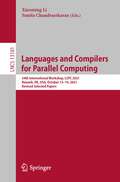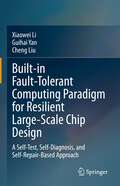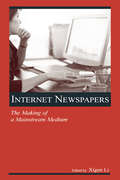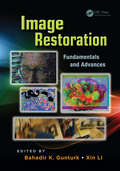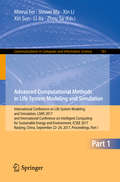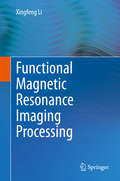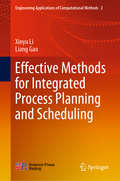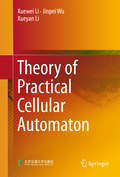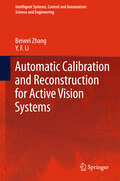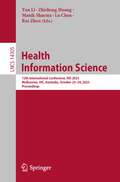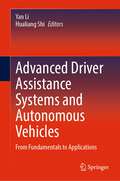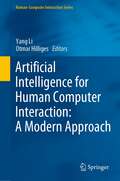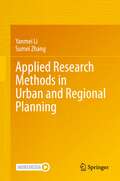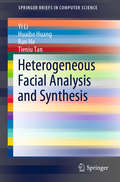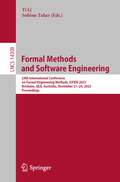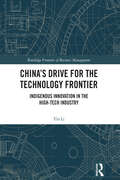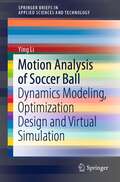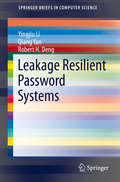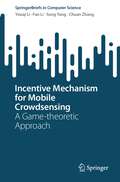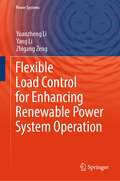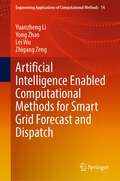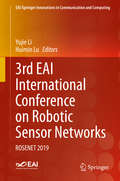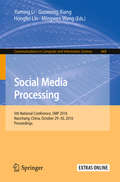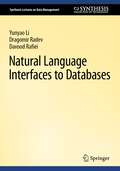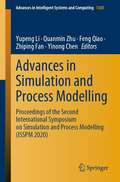- Table View
- List View
Languages and Compilers for Parallel Computing: 34th International Workshop, LCPC 2021, Newark, DE, USA, October 13–14, 2021, Revised Selected Papers (Lecture Notes in Computer Science #13181)
by Xiaoming Li Sunita ChandrasekaranThis book constitutes the thoroughly refereed post-conference proceedings of the 34th International Workshop on Languages and Compilers for Parallel Computing, LCPC 2020, held in Delaware, NE, USA, in October 2021.Due to COVID-19 pandemic the conference was held virtually. The 9 revised full papers were carefully reviewed and selected from 11 submissions. The conference covers all aspects of languages, compiler techniques, run-time environments, and compiler-related performance evaluation for parallel and high-performance computing. The scope of the workshop encompasses foundational results, as well as practical experience reports and bold new ideas for future systems.
Built-in Fault-Tolerant Computing Paradigm for Resilient Large-Scale Chip Design: A Self-Test, Self-Diagnosis, and Self-Repair-Based Approach
by Xiaowei Li Guihai Yan Cheng LiuWith the end of Dennard scaling and Moore’s law, IC chips, especially large-scale ones, now face more reliability challenges, and reliability has become one of the mainstay merits of VLSI designs. In this context, this book presents a built-in on-chip fault-tolerant computing paradigm that seeks to combine fault detection, fault diagnosis, and error recovery in large-scale VLSI design in a unified manner so as to minimize resource overhead and performance penalties. Following this computing paradigm, we propose a holistic solution based on three key components: self-test, self-diagnosis and self-repair, or “3S” for short. We then explore the use of 3S for general IC designs, general-purpose processors, network-on-chip (NoC) and deep learning accelerators, and present prototypes to demonstrate how 3S responds to in-field silicon degradation and recovery under various runtime faults caused by aging, process variations, or radical particles. Moreover, we demonstrate that 3S not only offers a powerful backbone for various on-chip fault-tolerant designs and implementations, but also has farther-reaching implications such as maintaining graceful performance degradation, mitigating the impact of verification blind spots, and improving chip yield. This book is the outcome of extensive fault-tolerant computing research pursued at the State Key Lab of Processors, Institute of Computing Technology, Chinese Academy of Sciences over the past decade. The proposed built-in on-chip fault-tolerant computing paradigm has been verified in a broad range of scenarios, from small processors in satellite computers to large processors in HPCs. Hopefully, it will provide an alternative yet effective solution to the growing reliability challenges for large-scale VLSI designs.
Internet Newspapers: The Making of a Mainstream Medium (Routledge Communication Series)
by Xigen LiInternet Newspapers: The Making of a Mainstream Medium examines newspapers on the Internet, and addresses the emergence of online newspapers and the delivery of news through this outlet. Utilizing empirical research, chapters explore the theoretical and practical issues associated with Internet newspapers and examine the process through which online newspapers have grown into a mainstream medium. Contributions to this work emphasize three key areas: the structure and presentation of newspapers on the Internet; the medium as an interactive process; and the ways in which the public interacts with Internet newspapers.This collection makes a substantial contribution to the understanding of newspapers on the Internet, covering their development and changes as well as the impact that news delivery through this medium has had on other media, audiences, and society. It also sheds light on improving operation and performance of Internet newspapers to better serve the public and gain competitive knowledge. The volume encourages additional scholarship in this area, and also shows how researchers can benefit from an empirical approach to their examination of Internet newspapers.Internet Newspapers will appeal to scholars, researchers, and students of journalism and mass communications, and can be used as a supplementary text in advanced courses covering journalism, communication technology, and mass media and society.
Image Restoration: Fundamentals and Advances (Digital Imaging and Computer Vision #7)
by Xin Li Bahadir K. GunturkImage Restoration: Fundamentals and Advances responds to the need to update most existing references on the subject, many of which were published decades ago. Providing a broad overview of image restoration, this book explores breakthroughs in related algorithm development and their role in supporting real-world applications associated with various scientific and engineering fields. These include astronomical imaging, photo editing, and medical imaging, to name just a few. The book examines how such advances can also lead to novel insights into the fundamental properties of image sources. Addressing the many advances in imaging, computing, and communications technologies, this reference strikes just the right balance of coverage between core fundamental principles and the latest developments in this area. Its content was designed based on the idea that the reproducibility of published works on algorithms makes it easier for researchers to build on each other’s work, which often benefits the vitality of the technical community as a whole. For that reason, this book is as experimentally reproducible as possible. Topics covered include: Image denoising and deblurring Different image restoration methods and recent advances such as nonlocality and sparsity Blind restoration under space-varying blur Super-resolution restoration Learning-based methods Multi-spectral and color image restoration New possibilities using hybrid imaging systems Many existing references are scattered throughout the literature, and there is a significant gap between the cutting edge in image restoration and what we can learn from standard image processing textbooks. To fill that need but avoid a rehash of the many fine existing books on this subject, this reference focuses on algorithms rather than theories or applications. Giving readers access to a large amount of downloadable source code, the book illustrates fundamental techniques, key ideas developed over the years, and the state of the art in image restoration. It is a valuable resource for readers at all levels of understanding.
Advanced Computational Methods in Life System Modeling and Simulation: International Conference on Life System Modeling and Simulation, LSMS 2017 and International Conference on Intelligent Computing for Sustainable Energy and Environment, ICSEE 2017, Nanjing, China, September 22-24, 2017, Proceedings, Part I (Communications in Computer and Information Science #761)
by Xin Li Xin Sun Zhou Su Minrui Fei Shiwei Ma Li JiaThe three-volume set CCIS 761, CCIS 762, and CCIS 763 constitutes the thoroughly refereed proceedings of the International Conference on Life System Modeling and Simulation, LSMS 2017, and of the International Conference on Intelligent Computing for Sustainable Energy and Environment, ICSEE 2017, held in Nanjing, China, in September 2017. The 208 revised full papers presented were carefully reviewed and selected from over 625 submissions. The papers of this volume are organized in topical sections on: Biomedical Signal Processing; Computational Methods in Organism Modeling; Medical Apparatus and Clinical Applications; Bionics Control Methods, Algorithms and Apparatus; Modeling and Simulation of Life Systems; Data Driven Analysis; Image and Video Processing; Advanced Fuzzy and Neural Network Theory and Algorithms; Advanced Evolutionary Methods and Applications; Advanced Machine Learning Methods and Applications; Intelligent Modeling, Monitoring, and Control of Complex Nonlinear Systems; Advanced Methods for Networked Systems; Control and Analysis of Transportation Systems; Advanced Sliding Mode Control and Applications; Advanced Analysis of New Materials and Devices; Computational Intelligence in Utilization of Clean and Renewable Energy Resources; Intelligent Methods for Energy Saving and Pollution Reduction; Intelligent Methods in Developing Electric Vehicles, Engines and Equipment; Intelligent Computing and Control in Power Systems; Modeling, Simulation and Control in Smart Grid and Microgrid; Optimization Methods; Computational Methods for Sustainable Environment.
Functional Magnetic Resonance Imaging Processing
by Xingfeng LiWith strong numerical and computational focus, this book serves as an essential resource on the methods for functional neuroimaging analysis, diffusion weighted image analysis, and longitudinal VBM analysis. It includes four MRI image modalities analysis methods. The first covers the PWI methods, which is the basis for understanding cerebral flow in human brain. The second part, the book's core, covers fMRI methods in three specific domains: first level analysis, second level analysis, and effective connectivity study. The third part covers the analysis of Diffusion weighted image, i. e. DTI, QBI and DSI image analysis. Finally, the book covers (longitudinal) VBM methods and its application to Alzheimer's disease study.
Effective Methods for Integrated Process Planning and Scheduling (Engineering Applications of Computational Methods #2)
by Xinyu Li Liang GaoThis book summarizes a series of research work on integrated process planning and scheduling (IPPS) done by the authors, focusing on discussing the properties, novel solution methods and applications of process planning, scheduling and IPPS problems under different machining environments. It is a valuable reference resource for teachers, students and researchers working in the fields of engineering, management science and other related disciplines.
Theory of Practical Cellular Automaton
by Xueyan Li Jinpei Wu Xuewei LiThis book addresses the intellectual foundations, function, modeling approaches and complexity of cellular automata; explores cellular automata in combination with genetic algorithms, neural networks and agents; and discusses the applications of cellular automata in economics, traffic and the spread of disease. Pursuing a blended approach between knowledge and philosophy, it assigns equal value to methods and applications.
Automatic Calibration and Reconstruction for Active Vision Systems (Intelligent Systems, Control and Automation: Science and Engineering #57)
by Y. F. Li Beiwei ZhangIn this book, the design of two new planar patterns for camera calibration of intrinsic parameters is addressed and a line-based method for distortion correction is suggested. The dynamic calibration of structured light systems, which consist of a camera and a projector is also treated. Also, the 3D Euclidean reconstruction by using the image-to-world transformation is investigated. Lastly, linear calibration algorithms for the catadioptric camera are considered, and the homographic matrix and fundamental matrix are extensively studied. In these methods, analytic solutions are provided for the computational efficiency and redundancy in the data can be easily incorporated to improve reliability of the estimations. This volume will therefore prove valuable and practical tool for researchers and practioners working in image processing and computer vision and related subjects.
Health Information Science: 12th International Conference, HIS 2023, Melbourne, VIC, Australia, October 23–24, 2023, Proceedings (Lecture Notes in Computer Science #14305)
by Yan Li Zhisheng Huang Manik Sharma Lu Chen Rui ZhouThis book constitutes the refereed proceedings of the 12th International Conference on Health Information Science, HIS 2023, held in Melbourne, VIC, Australia, during October 23–24, 2023.The 20 full papers and 9 short papers included in this book were carefully reviewed and selected from 54 submissions. They were organized in topical sections as follows: Depression & Mental Health, Data Security, Privacy & Healthcare Systems, Neurological & Cognitive Disease Studies, COVID-19 Impact Studies, Advanced Medical Data & AI Techniques, Predictive Analysis & Disease Recognition, Medical Imaging & Dataset Exploration, Elderly Care and Knowledge Systems.
Advanced Driver Assistance Systems and Autonomous Vehicles: From Fundamentals to Applications
by Yan Li Hualiang ShiThis book provides a comprehensive reference for both academia and industry on the fundamentals, technology details, and applications of Advanced Driver-Assistance Systems (ADAS) and autonomous driving, an emerging and rapidly growing area. The book written by experts covers the most recent research results and industry progress in the following areas: ADAS system design and test methodologies, advanced materials, modern automotive technologies, artificial intelligence, reliability concerns, and failure analysis in ADAS. Numerous images, tables, and didactic schematics are included throughout. This essential book equips readers with an in-depth understanding of all aspects of ADAS, providing insights into key areas for future research and development. • Provides comprehensive coverage of the state-of-the-art in ADAS • Covers advanced materials, deep learning, quality and reliability concerns, and fault isolation and failure analysis • Discusses ADAS system design and test methodologies, novel automotive technologies • Features contributions from both academic and industry authors, for a complete view of this important technology
Artificial Intelligence for Human Computer Interaction: A Modern Approach (Human–Computer Interaction Series)
by Yang Li Otmar HilligesThis edited book explores the many interesting questions that lie at the intersection between AI and HCI. It covers a comprehensive set of perspectives, methods and projects that present the challenges and opportunities that modern AI methods bring to HCI researchers and practitioners. The chapters take a clear departure from traditional HCI methods and leverage data-driven and deep learning methods to tackle HCI problems that were previously challenging or impossible to address.It starts with addressing classic HCI topics, including human behaviour modeling and input, and then dedicates a section to data and tools, two technical pillars of modern AI methods. These chapters exemplify how state-of-the-art deep learning methods infuse new directions and allow researchers to tackle long standing and newly emerging HCI problems alike. Artificial Intelligence for Human Computer Interaction: A Modern Approach concludes with a section on Specific Domains which covers a set of emerging HCI areas where modern AI methods start to show real impact, such as personalized medical, design, and UI automation.
Applied Research Methods in Urban and Regional Planning
by Yanmei Li Sumei ZhangThis book introduces the fundamentals of research methods and how they apply to the discipline of urban and regional planning. Written at a level appropriate for upper-level undergraduate and beginning master’s level students, the text fills a gap in the literature for textbooks on urban planning. Additionally, the book can be used as a reference for planning practitioners and researchers when analyzing quantitative and qualitative data in urban and regional planning and related fields.The volume does not assume advanced knowledge of mathematical formulas. Rather, it begins with the essentials of research methods, such as the identification of the research problems in planning, the literature review, data collection and presentation, descriptive data analysis, and report of findings. Its discipline-specific topics include field research methods, qualitative data analysis, economic and demographic analysis, evaluation research, and methods in sub-disciplines such as land use planning, transportation planning, environmental planning, and housing analysis. Designed with instruction in mind, this book features downloadable materials, including learning outcomes, chapter highlights, chapter review questions, datasets, and certain Excel models. Students will be able to download review questions to enhance the learning process and datasets to practice methods.
Heterogeneous Facial Analysis and Synthesis (SpringerBriefs in Computer Science)
by Yi Li Huaibo Huang Ran He Tieniu TanThis book presents a comprehensive review of heterogeneous face analysis and synthesis, ranging from the theoretical and technical foundations to various hot and emerging applications, such as cosmetic transfer, cross-spectral hallucination and face rotation. Deep generative models have been at the forefront of research on artificial intelligence in recent years and have enhanced many heterogeneous face analysis tasks. Not only has there been a constantly growing flow of related research papers, but there have also been substantial advances in real-world applications. Bringing these together, this book describes both the fundamentals and applications of heterogeneous face analysis and synthesis. Moreover, it discusses the strengths and weaknesses of related methods and outlines future trends. Offering a rich blend of theory and practice, the book represents a valuable resource for students, researchers and practitioners who need to construct face analysis systems with deep generative networks.
Formal Methods and Software Engineering: 24th International Conference on Formal Engineering Methods, ICFEM 2023, Brisbane, QLD, Australia, November 21–24, 2023, Proceedings (Lecture Notes in Computer Science #14308)
by Yi Li Sofiène TaharThis book constitutes the proceedings of the 24th International Conference on Formal Methods and Software Engineering, ICFEM 2023, held in Brisbane, QLD, Australia, during November 21–24, 2023.The 13 full papers presented together with 8 doctoral symposium papers in this volume were carefully reviewed and selected from 34 submissions, the volume also contains one invited paper. The conference focuses on applying formal methods to practical applications and presents papers for research in all areas related to formal engineering methods.
China’s Drive for the Technology Frontier: Indigenous Innovation in the High-Tech Industry (Routledge Frontiers of Business Management)
by Yin LiChina has become an innovation powerhouse in high-tech industries, but the widely held view assumes the Chinese model is built on technological borrowing and state capitalism. This book debunks the myths surrounding the Chinese model with a fresh take on China’s strategies for technological innovation. The central argument is that indigenous innovation plays a critical role in transforming the Chinese high-tech industry. Like any successfully industrialized nation in history, indigenous innovation in China allows industrial enterprises to assimilate knowledge developed elsewhere, utilize science and technology resources and human capabilities accumulated in the country, and eventually approach the technological frontier. The question is, how do Chinese businesses and governments engage in indigenous innovation? Employing the "social conditions of innovative enterprise" framework developed by William Lazonick and colleagues, this book analyzes how the interaction of strategy, organization, and finance in leading Chinese high-tech firms underpinned by national institutions enables indigenous innovation with Chinese characteristics. It features detailed case studies of two critical high-tech industries—the telecom-equipment industry and the semiconductor industry—and within them, the business histories of leading Chinese innovators. The in-depth look into China’s experience in indigenous innovation provides valuable lessons for advanced and emerging economies.
Motion Analysis of Soccer Ball: Dynamics Modeling, Optimization Design and Virtual Simulation (SpringerBriefs in Applied Sciences and Technology)
by Ying LiThe intelligent sports analysis of a soccer ball (also known as football, football ball, or association football ball) requires accurately simulating its motion and finding the best design parameters. Employing classic mechanics, this book establishes a fundamental framework for the soccer ball multi-body dynamics modeling, virtual prototype simulation and optimization design. It presents 3D virtual prototypes to predict the soccer ball trajectory for soccer players and trainers. Five typical case studies have addressed in the kinematics and dynamics simulations of soccer ball projectile motion, free kick, and corner kick in the virtual environment. The research on multi-body dynamics models provides a useful method for engineers and scientists to investigate the spatial kinematics and dynamics performances of various balls, such as soccer ball, gulf ball, American football, etc. The book is significant to guide undergraduate and graduate students from multi-disciplines to study system dynamics and optimization design.
Leakage Resilient Password Systems
by Yingjiu Li Qiang Yan Robert H. DengThis book investigates tradeoff between security and usability in designing leakage resilient password systems (LRP) and introduces two practical LRP systems named Cover Pad and ShadowKey. It demonstrates that existing LRP systems are subject to both brute force attacks and statistical attacks and that these attacks cannot be effectively mitigated without sacrificing the usability of LRP systems. Quantitative analysis proves that a secure LRP system in practical settings imposes a considerable amount of cognitive workload unless certain secure channels are involved. The book introduces a secure and practical LRP system, named Cover Pad, for password entry on touch-screen mobile devices. Cover Pad leverages a temporary secure channel between a user and a touch screen which can be easily realized by placing a hand shielding gesture on the touch screen. The temporary secure channel is used to deliver a hidden message to the user for transforming each password symbol before entering it on the touch screen. A user study shows the impact of these testing conditions on the users' performance in practice. Finally, this book introduces a new LRP system named ShadowKey. Shadow Key is designed to achieve better usability for leakage resilient password entry. It leverages either a permanent secure channel, which naturally exists between a user and the display unit of certain mobile devices, or a temporary secure channel, which can be easily realized between a user and a touch screen with a hand-shielding gesture. The secure channel protects the mappings between original password symbols and associated random symbols. Unlike previous LRP system users, Shadow Key users do not need to remember anything except their passwords. Leakage Resilient Password Systems is designed for professionals working in the security industry. Advanced-level students studying computer science and electrical engineering will find this brief full of useful material.
Incentive Mechanism for Mobile Crowdsensing: A Game-theoretic Approach (SpringerBriefs in Computer Science)
by Youqi Li Fan Li Song Yang Chuan ZhangMobile crowdsensing (MCS) is emerging as a novel sensing paradigm in the Internet of Things (IoTs) due to the proliferation of smart devices (e.g., smartphones, wearable devices) in people’s daily lives. These ubiquitous devices provide an opportunity to harness the wisdom of crowds by recruiting mobile users to collectively perform sensing tasks, which largely collect data about a wide range of human activities and the surrounding environment. However, users suffer from resource consumption such as battery, processing power, and storage, which discourages users’ participation. To ensure the participation rate, it is necessary to employ an incentive mechanism to compensate users’ costs such that users are willing to take part in crowdsensing. This book sheds light on the design of incentive mechanisms for MCS in the context of game theory. Particularly, this book presents several game-theoretic models for MCS in different scenarios. In Chapter 1, the authors present an overview of MCS and state the significance of incentive mechanism for MCS. Then, in Chapter 2, 3, 4, and 5, the authors propose a long-term incentive mechanism, a fair incentive mechanism, a collaborative incentive mechanism, and a coopetition-aware incentive mechanism for MCS, respectively. Finally, Chapter 6 summarizes this book and point out the future directions. This book is of particular interest to the readers and researchers in the field of IoT research, especially in the interdisciplinary field of network economics and IoT.
Flexible Load Control for Enhancing Renewable Power System Operation (Power Systems)
by Yuanzheng Li Yang Li Zhigang ZengThis book addresses the pressing challenges faced by renewable power system operation (RPSO) due to the increasing penetration of renewable energy and flexible load. These challenges can be divided into two categories. Firstly, the inherent uncertainties associated with renewable energy sources pose significant difficulties in RPSO. Secondly, the presence of various types of flexible load, along with their complex constraint relationships, adds to the operational complexities. Recognizing the growing emphasis on the economic and low-carbon aspects of RPSO, this book focuses on the key issues of flexible load control. It mainly consists of following categories: (1) The control of data centers, a booming flexible load, to enhance RPSO through renewable energy integration and advanced robust multi-objective optimization. (2) The introduction of flexible industrial load control, employing effective demand-supply cooperative responding strategies for RPSO. (3) The exploration of electricvehicle flexible charging load control and centralized electric vehicle charging system control in the context of RPSO. The book also covers the emerging field of flexible integrated load control for renewable energy-based comprehensive energy system operation. Aimed at researchers, engineers, and graduate students in electrical engineering and computer science, this book provides a valuable resource for understanding and implementing flexible load control in the context of RPSO.
Artificial Intelligence Enabled Computational Methods for Smart Grid Forecast and Dispatch (Engineering Applications of Computational Methods #14)
by Yuanzheng Li Yong Zhao Lei Wu Zhigang ZengWith the increasing penetration of renewable energy and distributed energy resources, smart grid is facing great challenges, which could be divided into two categories. On the one hand, the endogenous uncertainties of renewable energy and electricity load lead to great difficulties in smart grid forecast. On the other hand, massive electric devices as well as their complex constraint relationships bring about significant difficulties in smart grid dispatch. Owe to the rapid development of artificial intelligence in recent years, several artificial intelligence enabled computational methods have been successfully applied in the smart grid and achieved good performances. Therefore, this book is concerned with the research on the key issues of artificial intelligence enabled computational methods for smart grid forecast and dispatch, which consist of three main parts. (1) Introduction for smart grid forecast and dispatch, in inclusion of reviewing previous contribution of various research methods as well as their drawbacks to analyze characteristics of smart grid forecast and dispatch.(2) Artificial intelligence enabled computational methods for smart grid forecast problems, which are devoted to present the recent approaches of deep learning and machine learning as well as their successful applications in smart grid forecast.(3) Artificial intelligence enabled computational methods for smart grid dispatch problems, consisting of edge-cutting intelligent decision-making approaches, which help determine the optimal solution of smart grid dispatch. The book is useful for university researchers, engineers, and graduate students in electrical engineering and computer science who wish to learn the core principles, methods, algorithms, and applications of artificial intelligence enabled computational methods.
3rd EAI International Conference on Robotic Sensor Networks: ROSENET 2019 (EAI/Springer Innovations in Communication and Computing)
by Yujie Li Huimin LuThis proceedings presents the papers of the 3rd EAI International Conference on Robotic Sensor Networks (ROSENET 2019). The conference explores the integration of networks and robotic technologies, which has become a topic of increasing interest for both researchers and developers from academic fields and industries worldwide. The authors posit that big networks will be the main approach to the next generation of robotic research, The book discusses how the explosive number of network models and increasing computational power of computers significantly extends the number of potential applications for robotic technologies while also bringing new challenges to each network's community. The conference provided a platform for researchers to share up-to-date scientific achievements in this field. The conference took place August 17, 2019, Kitakyushu, Japan.Presents the proceedings of the 3rd EAI International Conference on Robotic Sensor Networks (ROSENET 2019), August 17, 2019, Kitakyushu, JapanFeatures papers on robotic technologies for healthcare, medicine, military and moreIncludes perspectives from a multi-disciplinary selection of global researchers, academics, and professionals
Social Media Processing
by Yuming Li Guoxiong Xiang Hongfei Lin Mingwen WangThis book constitutes the thoroughly refereed proceedings of the 5th National Conference of Social Media Processing, SMP 2016, held in Nanchang, China, in October 2016. The 24 revised full papers presented were carefully reviewed and selected from 109 submissions. The papers address issues such as: mining social media and applications; natural language processing; data mining; information retrieval; emergent social media processing problems.
Natural Language Interfaces to Databases (Synthesis Lectures on Data Management)
by Yunyao Li Dragomir Radev Davood RafieiThis book presents a comprehensive overview of Natural Language Interfaces to Databases (NLIDBs), an indispensable tool in the ever-expanding realm of data-driven exploration and decision making. After first demonstrating the importance of the field using an interactive ChatGPT session, the book explores the remarkable progress and general challenges faced with real-world deployment of NLIDBs. It goes on to provide readers with a holistic understanding of the intricate anatomy, essential components, and mechanisms underlying NLIDBs and how to build them. Key concepts in representing, querying, and processing structured data as well as approaches for optimizing user queries are established for the reader before their application in NLIDBs is explored. The book discusses text to data through early relevant work on semantic parsing and meaning representation before turning to cutting-edge advancements in how NLIDBs are empowered to comprehend and interpret human languages. Various evaluation methodologies, metrics, datasets and benchmarks that play a pivotal role in assessing the effectiveness of mapping natural language queries to formal queries in a database and the overall performance of a system are explored. The book then covers data to text, where formal representations of structured data are transformed into coherent and contextually relevant human-readable narratives. It closes with an exploration of the challenges and opportunities related to interactivity and its corresponding techniques for each dimension, such as instances of conversational NLIDBs and multi-modal NLIDBs where user input is beyond natural language. This book provides a balanced mixture of theoretical insights, practical knowledge, and real-world applications that will be an invaluable resource for researchers, practitioners, and students eager to explore the fundamental concepts of NLIDBs.
Advances in Simulation and Process Modelling: Proceedings of the Second International Symposium on Simulation and Process Modelling (ISSPM 2020) (Advances in Intelligent Systems and Computing #1305)
by Yupeng Li Quanmin Zhu Feng Qiao Zhiping Fan Yinong ChenThis book gathers the selected papers from the Second International Symposium on Simulation and Process Modelling (ISSPM 2020), which was held online on August 29-30, 2020, due to COVID-19 pandemic. The Symposium provides a forum in virtual presentation for scholars, researchers and practitioners who are interested in the modelling and simulation of business processes, production and industrial processes, service and administrative processes, and public sector processes to develop theory and practice of simulation and process modelling.
